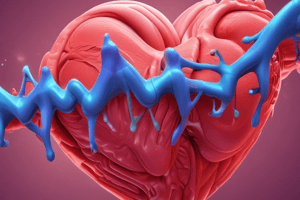Podcast
Questions and Answers
What is the therapeutic classification of Digoxin?
What is the therapeutic classification of Digoxin?
Inotropes
What is the pharmacologic classification of Digoxin?
What is the pharmacologic classification of Digoxin?
Cardiac glycosides
What are the available forms of Digoxin?
What are the available forms of Digoxin?
Oral solution: 0.05 mg/mL (pediatric); Tablets: 0.0625 mg; 0.125 mg; 0.25 mg
What are the primary indications for using Digoxin?
What are the primary indications for using Digoxin?
What should be monitored before administering Digoxin?
What should be monitored before administering Digoxin?
What are common adverse reactions to Digoxin?
What are common adverse reactions to Digoxin?
What is the pregnancy category of Digoxin?
What is the pregnancy category of Digoxin?
What drug-drug interaction should be monitored when administering Digoxin?
What drug-drug interaction should be monitored when administering Digoxin?
What nursing considerations are important when administering Digoxin?
What nursing considerations are important when administering Digoxin?
What does the black box warning state for Digoxin?
What does the black box warning state for Digoxin?
What patient teaching should be provided regarding Digoxin?
What patient teaching should be provided regarding Digoxin?
Flashcards are hidden until you start studying
Study Notes
Digoxin (Lanoxin) Study Notes
-
Therapeutic Classification: Classified as inotropes, which enhance cardiac output by increasing the force of contraction.
-
Pharmacologic Classification: Known as cardiac glycosides, a class of medications that have a specific effect on heart function.
-
Available Forms:
- Oral solution: 0.05 mg/mL (for pediatric use)
- Tablets: Available in strengths of 0.0625 mg, 0.125 mg, and 0.25 mg.
-
Indications:
- Primarily used to treat heart failure, including both rapid and gradual digitalization.
- Effective for managing chronic atrial fibrillation to stabilize heart rhythm.
-
Administration Guidelines:
- Prior to loading dose, gather baseline data including heart rate, blood pressure, and electrolyte levels.
- Measure apical-radial pulse for one full minute before administration; record significant changes and notify prescriber.
- If abnormalities occur, assess blood pressure and perform a 12-lead ECG for further evaluation.
-
Adverse Reactions:
- Central Nervous System: Symptoms can include agitation, fatigue, dizziness, hallucinations, and visual disturbances.
- Cardiovascular: May lead to arrhythmias and heart block.
- Gastrointestinal: Common reactions include nausea, vomiting, diarrhea, and anorexia.
- Visual disturbances: Blurred vision, yellow-green halos, and photophobia can occur.
-
Pregnancy Category: Classified as Category C; animal studies indicate risks, hence caution is recommended but benefits may outweigh risks.
-
Drug-Drug Interactions:
- Notably with loop diuretics (e.g., Furosemide) which may cause hypokalemia and hypomagnesemia, increasing the risk of digoxin toxicity.
- Monitoring of electrolyte levels is essential.
-
Nursing Considerations:
- Vigilantly monitor for signs of toxicity, which can be life-threatening.
- Symptoms of toxicity include nausea, vomiting, visual changes, and arrhythmias.
- Increased risk of toxicity is present in older adults, those with renal impairment, or those with low body weight.
- Withhold medication if slow pulse rate (60 bpm or less) is observed and notify the prescriber.
- Carefully monitor potassium levels to prevent hypokalemia and manage hyperkalemia as a result of toxicity.
-
Black Box Warning: Not applicable for Digoxin.
-
Patient Teaching:
- Educate patients and their families on drug actions, dosing, and pulse-taking techniques.
- Advise reporting pulse rates below 60 bpm or above 110 bpm, along with any skipped beats or rhythm changes.
- Instruct on recognizing adverse effects that could signal toxicity.
- Counsel on the importance of potassium-rich diets and maintaining consistency with medication brands.
- Warn patients to avoid herbal supplements without consulting a prescriber.
Studying That Suits You
Use AI to generate personalized quizzes and flashcards to suit your learning preferences.




